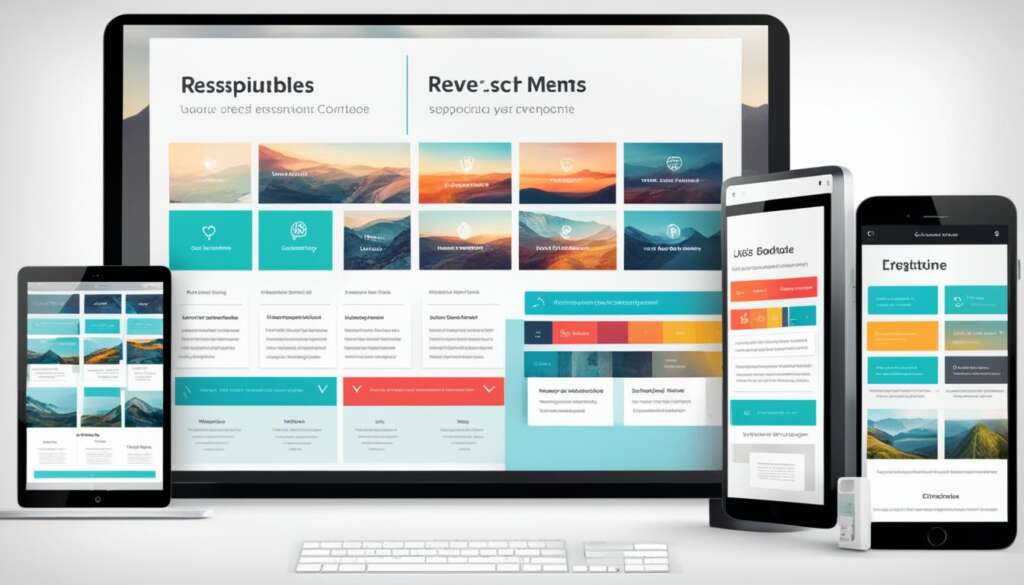Table of Contents
Responsive web design is an approach in web development that focuses on creating websites that can adapt and respond to the user’s behaviour and environment. This includes considerations such as screen size, platform, and orientation. The practice involves the use of flexible grids and layouts, images, and CSS media queries to ensure that the website can automatically adjust and accommodate different screen resolutions, image sizes, and scripting abilities. The goal is to create a seamless user experience across various devices and eliminate the need for separate design and development for each new gadget on the market.
Adjusting Screen Resolution
One of the challenges in responsive web design is accommodating varying screen resolutions and orientations. With the proliferation of new devices with different screen sizes, it becomes impractical to create a separate design for each one. Instead, responsive design relies on flexible layouts, media queries, and fluid grids to adapt the website’s appearance and functionality to different screen sizes.
This includes considerations for both landscape and portrait orientations, as well as the use of responsive images that can resize and reposition themselves based on the available screen space.
| Key Challenges | Advantages of Responsive Design |
|---|---|
| – Varying screen resolutions | – Improved user experience across devices |
| – Different screen orientations | – Cost-effective compared to maintaining multiple designs |
| – New devices with unique screen sizes | – SEO benefits from improved mobile user experience |
Responsive design allows websites to easily rank higher on search engine results pages, as it is favored by search engines like Google.
By implementing flexible layouts, media queries, and fluid grids, responsive design ensures that websites can seamlessly adapt to different screen resolutions and orientations, providing a consistent user experience across devices. Furthermore, the use of responsive images allows for optimal resizing and repositioning to fit the available screen space.
Overall, adjusting screen resolution is a fundamental aspect of responsive web design, enabling websites to cater to the diverse range of devices and screen sizes in today’s digital landscape.
Part of the Solution: Flexible Everything
In the past, flexible layouts were considered a luxury for websites. However, the advancement of responsive web design has revolutionized the way we approach design and made it possible to create more adaptable and user-friendly websites. With responsive web design thinking, designers now have the tools and techniques to build websites that can seamlessly adjust to different screen sizes and devices.
A crucial aspect of responsive web design is the implementation of flexible layouts. By using flexible grids and CSS media queries, web designers can create layouts that dynamically adapt to the available screen space, ensuring that content is presented in an optimal way regardless of the device being used. This flexibility enables a consistent user experience and eliminates the need for separate designs for different devices, saving time and resources.
Another essential element of responsive web design is the inclusion of flexible images. These images can automatically adjust their size and positioning based on the screen resolution, ensuring that they always look their best. Whether it’s hiding and revealing portions of images or creating sliding composite images, the goal is to make the website visually appealing and functional across various devices.
Responsive web design thinking encourages designers to think about the adaptability and flexibility of their designs from the outset. It’s no longer enough to simply create a fixed design that looks good on one screen size. In today’s digital landscape, it’s essential to consider the multitude of devices and screen sizes that users may be using to access your website.
By adopting a responsive web design approach and embracing flexible layouts and images, you can ensure that your website provides a seamless experience for users across different devices, improving user satisfaction and engagement.
Key Benefits of Using Flexible Layouts and Images:
- Improved user experience: Websites that adjust to different screen sizes and devices provide a better user experience, leading to increased engagement and satisfaction.
- Broader reach: With responsive web design, your website can be accessed and viewed seamlessly across various devices, expanding your reach to a wider audience.
- Search engine optimization: Responsive websites are favored by search engines like Google, leading to higher rankings in search results and increased organic traffic.
- Cost-effective: By designing flexible layouts and images, you eliminate the need for separate designs for different devices, saving time and costs in the long run.
Flexible Images
In the realm of responsive web design, managing images presents a unique challenge. Ensuring that images resize proportionately is a crucial aspect of achieving a responsive design. To address this, web developers employ various techniques, one of which involves utilizing CSS’s max-width property. With this property, images can be resized based on the screen or browser width, allowing them to adapt to different viewing areas. By default, the images load in their original sizes, but as the viewing area narrows, they adjust accordingly to maintain a seamless user experience.
When working with images in a responsive design, several factors should be considered to optimize performance. Image resolution plays a significant role in striking the right balance between image quality and file size. It is essential to find the optimal balance to ensure fast loading times and reduce bandwidth usage. Additionally, JavaScript can be employed to ensure that resized images render clearly in older browsers, further enhancing the user experience.
Implementing fluid and flexible images is a fundamental requirement in responsive web design, contributing to the overall success of a website’s adaptability across different devices and screen sizes. By leveraging the strength of CSS properties, such as max-width, and incorporating optimal resolution and JavaScript support, web designers can create visually appealing and adaptive experiences for users.
Conclusion
Responsive web design has become an essential aspect of today’s digital landscape. It plays a critical role in providing a seamless user experience by ensuring websites can be accessed and viewed effortlessly across a wide range of devices. By adapting to different screen sizes, responsive design allows users to navigate and interact with websites without any constraints, resulting in enhanced user satisfaction.
Moreover, responsive web design offers significant benefits in terms of search engine optimization (SEO). Search engines like Google prefer responsive websites as they provide a consistent user experience and improve website performance. As a result, responsive sites have a higher probability of ranking higher on search engine results pages, driving more organic traffic and improving online visibility.
In addition to improving user experience and SEO, responsive web design also proves to be cost-effective. With responsive design, there’s no need to create separate designs for different devices, saving valuable time and resources. Not only does this streamline the design process, but it also eliminates the need for excessive maintenance and updates, resulting in long-term cost savings for businesses.
In conclusion, responsive web design is a fundamental component of a successful online presence. It ensures a smooth user experience, boosts search engine rankings, and offers cost-effectiveness for businesses. With the ever-increasing variety of devices and screen sizes, embracing responsive design is crucial for businesses that strive to stay ahead in today’s digital-driven world.
FAQ
What is responsive web design?
Responsive web design is an approach in web development that focuses on creating websites that can adapt and respond to the user’s behavior and environment. This includes considerations such as screen size, platform, and orientation.
What are the key components of a responsive website?
The key components of a responsive website include flexible grids and layouts, CSS media queries, and the use of responsive images. These elements ensure that the website can automatically adjust and accommodate different screen resolutions, image sizes, and scripting abilities.
How does responsive design address varying screen resolutions and orientations?
Responsive design relies on flexible layouts, media queries, and fluid grids to adapt the website’s appearance and functionality to different screen sizes. This includes considerations for both landscape and portrait orientations, as well as the use of responsive images that can resize and reposition themselves based on the available screen space.
How does responsive web design make images adjust to different screen sizes?
Resizing images proportionately is an important aspect of ensuring a responsive design. One technique is to use CSS’s max-width property to resize images based on the available screen or browser width. This means that the images will load in their original sizes unless the viewing area becomes narrower, in which case the images will adjust accordingly.
What are the benefits of responsive web design?
Responsive web design provides a better user experience by ensuring that websites can be accessed and viewed seamlessly across devices. It also has benefits for search engine optimization, as responsive design is favored by search engines like Google. Furthermore, it eliminates the need for separate designs for different devices, saving time and costs in the long run.













